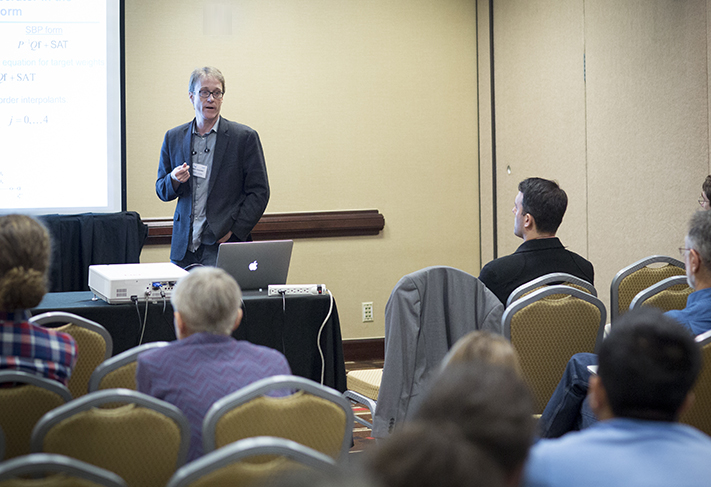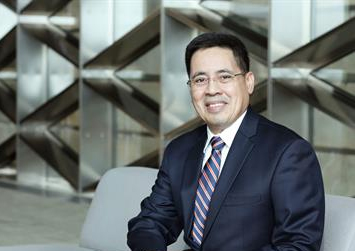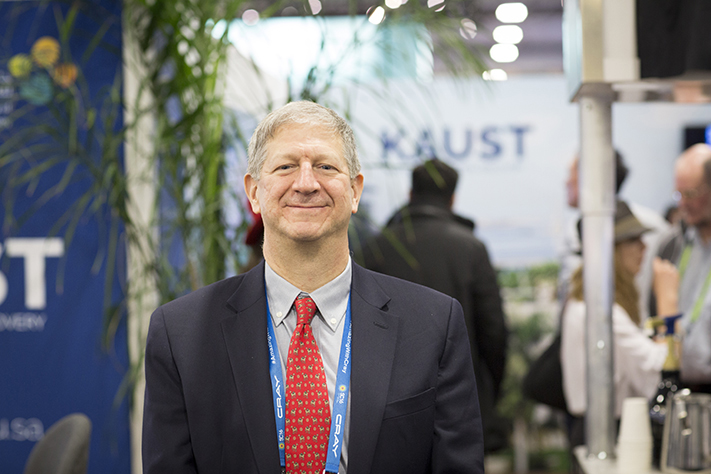An algorithm for success

NASA Senior Scientist Mark Carpenter speaks at the SIAM CSE 2017 conference in Atlanta, Georgia. Photo by Nicholas Demille.
In October of 2016, NASA Senior Scientist Mark Carpenter packed his suitcase and headed for the airport. His goal was to explore a research question that had intrigued him for years: Carpenter wanted to see if researchers could harness the power of the world's fastest computers to simulate the movement of objects through three-dimensional space in lifelike, dynamic atmospheric conditions (wind, water, collisions, etc.). The physics of such situations are understood when holding atmospheric conditions constant, but they are not known with a great degree of certainty under changing conditions—something that enormous computer-generated simulations could begin to provide if powered by the right algorithms.
"Ten to 15 years ago, we were happy to understand what happens to the wing of an airplane under normal conditions," Carpenter said. "Now, because of the growth in computing power, we are looking to model what happens to the entire plane under many different conditions. We want to solve the flight envelope from take off and landing to cruising and more."
As an applied mathematician, Carpenter excels at algorithm development—this is what he has worked on at the NASA Langley Research Center in Hampton, Virginia, U.S., for over 30 years. It was the pursuit of world-changing algorithm development and global supercomputing power that made Carpenter board a plan and head for one of the few places in the world where both things exist in equal measure—Thuwal, Saudi Arabia.
Fast forward to 2015 when a meeting of computational scientists and industry leaders formally announced that the seventh fastest supercomputer in the world was at KAUST. It's a monumental leap for any institution anywhere, made more surprising by the University's location in Thuwal. Equally as important for Carpenter's work, the team that operates and optimizes the supercomputer is also one of the world's most progressive, when it comes to algorithms for large systems of linear algebraic equations.
Amidst the noise and excitement of an international research conference in Atlanta, Georgia, U.S., KAUST Assistant Professor Matteo Parsani spoke about his work with Carpenter and how a grant from CRDF Global brought them back together to do something they had originally dreamed up during their time at Langley.
"We've come so far in our ability to work with colleagues around the world. Skype is good, but it doesn’t really work for the type of research that we do," said Parsani. "Our work is about standing together, writing out equations and coming up with ideas, doing proofs and pair programming. It is a different feeling when you do research in the same room, working on the same whiteboard compared to when you do it over Skype. The distance is damaging to the creative process.”

One of the four fellowships was awarded to Carpenter, a graduate of Carnegie Mellon University and former visiting professor at Uppsala University and TU Delft.

“This has happened because KAUST has built a reputation,” said Dr. Teofilo Abrajano, KAUST OSR director. "The confluence of game-changing infrastructure, excellent researchers and a growing track record of pioneering research outcomes has truly transformed KAUST into a global destination."
According to the website, "CRDF Global is an independent nonprofit organization that promotes international scientific and technical collaboration through grants, technical resources, training and services. CRDF Global believes that the world’s scientists and innovators must work together to help solve today’s global challenges in such areas as global health, nuclear, biological and chemical security, and the water, food, energy nexus," which, for anyone familiar with KAUST, is an obvious fit.
"I just want to point out that KAUST is already such a powerhouse that it draws this level of people. This is really the coalescence of numerous factors (highly cited researchers, world-class labs, global rankings, etc.). If all of these things hadn't been individually put in place, these people wouldn't have come here”
KAUST has ties to some of the world's most prestigious and storied scientific institutions. A number of KAUST faculty members, including Professor David Keyes, director of the Extreme Computing Research Center (ECRC), and Parsani are former participants in the NASA Langley mission and have conducted research there.
"I have known Dr. Carpenter for over 30 years," said Keyes. "He could have been a professor, but he preferred the long-term horizon for computational aerodynamics research at NASA. True to his hidden calling, he turned into a mentor as soon as he landed at KAUST. His office became populated by some of our talented Ph.D. students in numerical analysis and computer science."

"When it comes to this type of collaboration, there is both a near-term benefit and a long-term benefit," said Carpenter. "The KAUST ECRC is packed with people doing things that are closely related to computational fluid dynamics (CFD) in both direct and indirect ways that have a big impact on my research."
Carpenter lived on the KAUST campus for much of the Fall 2016 semester while he worked with various members of the ECRC team, including Parsani.
"We look at every visitor as a potential future employer of our students and an ambassador. In a short time, Mark planted seeds for the long term," said Keyes.
"We model fluid dynamics with high-performance computers, so we create the algorithms that will help do this modeling in the next generation of computers," said Carpenter.
"After the first month, we had many choices and we had to narrow down to deliver on four or five different paths toward an algorithm. It was a highly productive time," Parsani said. "From the numerical analysis point of view, we are close to having a complete answer, and that is really exciting."
"As often happens with research, we knew what we wanted to work on, but in the end, we came up with quite a number of ideas," said Carpenter.
Carpenter has plans to return to KAUST in May of 2017 to wrap up some of the research that he started with Parsani and others, and to promote wider application of it. He also has plans to take part in an OSR-sponsored conference on KAUST campus.
"The Predictive Complex Computational Fluid Dynamics conference we have in May will bring many people working in CFD to KAUST to try and merge ideas and move the discipline forward," said Parsani.
In October of 2016, NASA Senior Scientist Mark Carpenter packed his suitcase and headed for the airport. His goal was to explore a research question that had intrigued him for years: Carpenter wanted to see if researchers could harness the power of the world's fastest computers to simulate the movement of objects through three-dimensional space in lifelike, dynamic atmospheric conditions (wind, water, collisions, etc.). The physics of such situations are understood when holding atmospheric conditions constant, but they are not known with a great degree of certainty under changing conditions—something that enormous computer-generated simulations could begin to provide if powered by the right algorithms.
"Ten to 15 years ago, we were happy to understand what happens to the wing of an airplane under normal conditions," Carpenter said. "Now, because of the growth in computing power, we are looking to model what happens to the entire plane under many different conditions. We want to solve the flight envelope from take off and landing to cruising and more."
As an applied mathematician, Carpenter excels at algorithm development—this is what he has worked on at the NASA Langley Research Center in Hampton, Virginia, U.S., for over 30 years. It was the pursuit of world-changing algorithm development and global supercomputing power that made Carpenter board a plan and head for one of the few places in the world where both things exist in equal measure—Thuwal, Saudi Arabia.
Putting a research powerhouse on the map
In the early 2000s, the late Saudi King Abdullah bin Abdulaziz Al Saud set a plan in motion to grow the Saudi economy, including the establishment of a Saudi Arabia-based international university of science and technology modeled on the centuries-old Arab traditions of the House of Wisdom. However, King Abdullah wasn't looking just to bring the science in a big way—he was looking to help reframe some of the global imagination about where science is done at the highest levels and by whom.Fast forward to 2015 when a meeting of computational scientists and industry leaders formally announced that the seventh fastest supercomputer in the world was at KAUST. It's a monumental leap for any institution anywhere, made more surprising by the University's location in Thuwal. Equally as important for Carpenter's work, the team that operates and optimizes the supercomputer is also one of the world's most progressive, when it comes to algorithms for large systems of linear algebraic equations.
Amidst the noise and excitement of an international research conference in Atlanta, Georgia, U.S., KAUST Assistant Professor Matteo Parsani spoke about his work with Carpenter and how a grant from CRDF Global brought them back together to do something they had originally dreamed up during their time at Langley.
"We've come so far in our ability to work with colleagues around the world. Skype is good, but it doesn’t really work for the type of research that we do," said Parsani. "Our work is about standing together, writing out equations and coming up with ideas, doing proofs and pair programming. It is a different feeling when you do research in the same room, working on the same whiteboard compared to when you do it over Skype. The distance is damaging to the creative process.”

Matteo Parsani, KAUST Assistant Professor of Applied Mathematics and Computational Science. Photo by Nicholas Demille.
Facilitating collaboration
In April of 2016, the U.S. non-profit CRDF Global began taking applications for a KAUST Visiting Scholar Fellowship Program administered by the KAUST Office of Sponsored Research (OSR). The aim was to "facilitate collaborative research projects between Saudi and U.S. researchers and encourage academic exchange between the Saudi and the U.S. science community," according to the CRDF website. The 2016 fellowships, of which four were awarded in total, provided resources for U.S. researchers to travel to the Kingdom.One of the four fellowships was awarded to Carpenter, a graduate of Carnegie Mellon University and former visiting professor at Uppsala University and TU Delft.

Dr. Teofilo Abrajano, KAUST director of the Office of Sponsored Research.
“This has happened because KAUST has built a reputation,” said Dr. Teofilo Abrajano, KAUST OSR director. "The confluence of game-changing infrastructure, excellent researchers and a growing track record of pioneering research outcomes has truly transformed KAUST into a global destination."
According to the website, "CRDF Global is an independent nonprofit organization that promotes international scientific and technical collaboration through grants, technical resources, training and services. CRDF Global believes that the world’s scientists and innovators must work together to help solve today’s global challenges in such areas as global health, nuclear, biological and chemical security, and the water, food, energy nexus," which, for anyone familiar with KAUST, is an obvious fit.
"I just want to point out that KAUST is already such a powerhouse that it draws this level of people. This is really the coalescence of numerous factors (highly cited researchers, world-class labs, global rankings, etc.). If all of these things hadn't been individually put in place, these people wouldn't have come here”
KAUST has ties to some of the world's most prestigious and storied scientific institutions. A number of KAUST faculty members, including Professor David Keyes, director of the Extreme Computing Research Center (ECRC), and Parsani are former participants in the NASA Langley mission and have conducted research there.
"I have known Dr. Carpenter for over 30 years," said Keyes. "He could have been a professor, but he preferred the long-term horizon for computational aerodynamics research at NASA. True to his hidden calling, he turned into a mentor as soon as he landed at KAUST. His office became populated by some of our talented Ph.D. students in numerical analysis and computer science."
KAUST Professor David Keyes, director of the Extreme Computing Research Center. Photo by Nicholas Demille.
"When it comes to this type of collaboration, there is both a near-term benefit and a long-term benefit," said Carpenter. "The KAUST ECRC is packed with people doing things that are closely related to computational fluid dynamics (CFD) in both direct and indirect ways that have a big impact on my research."
Carpenter lived on the KAUST campus for much of the Fall 2016 semester while he worked with various members of the ECRC team, including Parsani.
"We look at every visitor as a potential future employer of our students and an ambassador. In a short time, Mark planted seeds for the long term," said Keyes.
Looking forward
Carpenter and Parsani develop algorithms for the next generation of computational fluid dynamics solvers. They are looking to write efficient algorithms that will allow researchers to more easily compute and understand the way that fluid materials—such as air and water—flow around objects in physical space."We model fluid dynamics with high-performance computers, so we create the algorithms that will help do this modeling in the next generation of computers," said Carpenter.
"After the first month, we had many choices and we had to narrow down to deliver on four or five different paths toward an algorithm. It was a highly productive time," Parsani said. "From the numerical analysis point of view, we are close to having a complete answer, and that is really exciting."
"As often happens with research, we knew what we wanted to work on, but in the end, we came up with quite a number of ideas," said Carpenter.
Carpenter has plans to return to KAUST in May of 2017 to wrap up some of the research that he started with Parsani and others, and to promote wider application of it. He also has plans to take part in an OSR-sponsored conference on KAUST campus.
"The Predictive Complex Computational Fluid Dynamics conference we have in May will bring many people working in CFD to KAUST to try and merge ideas and move the discipline forward," said Parsani.

